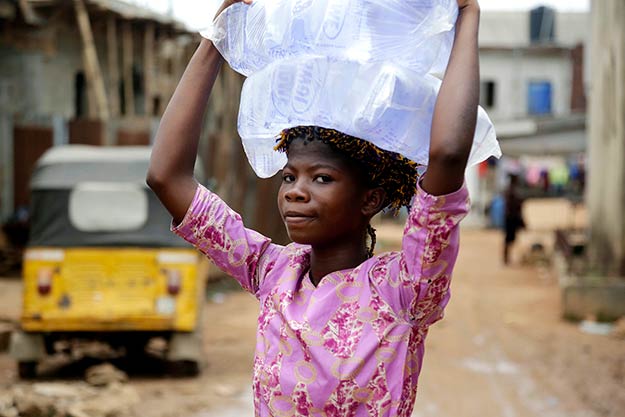In many families, the burden of collecting water falls to women and girls.
What could you do with an extra five hours in your day?
Get some more sleep? Maybe hit the gym? Read that book you’ve been meaning to start?
For women all over the world, an extra five hours a day would be a rare gift.
As we mark World Water Day, it’s worth realizing that for a family of four living without clean water available close to home, five hours is the amount of time required for collecting water – a burden most often borne by women and girls, who are usually tasked with the difficult and sometimes dangerous daily chore.
Some 844 million people don’t have access to clean water close to home – that is, water from a clean source within a 30-minute round trip. Even at this distance, a family trying to gather the WHO-recommended minimum 50 liters (13.2 gallons) per person would spend five hours a day lugging 20-liter jerrycans to and from water points. That adds up to 76 days each year.
Take a moment to consider all of the other things that can be accomplished in 76 days a year. It isn’t hard to see that spending so much time just fetching water means girls miss school and fall behind. It means women are less able to work or otherwise support and care for their families. And it means families are more likely to make do with whatever they can find – leading to higher rates of illness from drinking dirty water and adding further to the caring duties of the women in those families.
This creates a deadly cycle of poverty which becomes almost impossible to escape, as girls who drop out of school become more at risk for early marriage, and they, in turn, have children who miss out on education and marry too young.
WaterAid’s State of the World’s Water 2018: The Water Gap reveals Uganda, Niger, Mozambique, India and Pakistan are among the countries where the highest percentage or largest number of people cannot get clean water within a half-hour round trip; in many of these countries, there is also a significant wealth gap in accessing water, where most or all of the wealthiest will enjoy household connections even as the poorest still struggle. In all of these countries, the burden of water fetching lies predominantly with women and girls, limiting economic prospects and prosperity.
“The importance of water for women is huge. The girls in the village told me that before their school had a decent toilet, they would not go to school during menstruation, but that now they can attend lessons all month.”
Consider the example of Niger, one of the world’s least developed countriesas assessed by the U.N., and a country where 44 percent of people live in poverty. More than half of the population doesn’t have access to clean water close to home.
A women’s rights activist and photographer from neighboring Nigeria, Aisha Augie-Kuta, recently traveled to Niger with WaterAid to document the struggles of the community of Norandé, in the volatile Tillabéri region, which regularly endures both flooding and drought, and pollution from the river, as well as political instability and occasional militant attacks. This community on an island in the Niger river has historically relied upon the river for drinking water and all other needs, and has struggled with high rates of child illness.
“Norandé was very dry. Everything was brown and gray. There is so much water in the river nearby, but it is not clean,” Augie-Kuta said, describing the visit as a trip back in time compared to her modern home in Abuja.
“The importance of water for women is huge,” Augie-Kuta said. “The girls in the village told me that before their school had a decent toilet, they would not go to school during menstruation, but that now they can attend lessons all month.”
With climate change likely to exacerbate the challenges faced by this community and so many others like it, there is much more to be done.
We cannot achieve gender equality as long as there is water inequality. The absence of this basic life necessity holds women and girls back from realizing their potential. We know what the solution is. It’s time to get to work.
The views expressed in this article belong to the author and do not necessarily reflect the editorial policy of News Deeply.
This July, world leaders will meet in New York for a review of the United Nations’ Global Goal on water and sanitation, which aims to reach everyone, everywhere by 2030. WaterAid is calling for recognition that the U.N. Global Goals are everyone’s responsibility to deliver; for urgent action at all levels; for the inclusion of water, sanitation and hygiene in plans and programs around health, education, nutrition and gender equality; and for responsible environmental management that ensures enough clean water is protected and preserved for communities’ basic needs.
By Carolynne Wheeler
Source: https://www.globalcitizen.org/
Dear User/Visitor! Please, answer on our questions: tick off one of the positions – your answer will make us able to improve our site and make it more interesting and useful!


